Current (through May 3) degree day (DD) Accumulations
Location: UMass Cold Spring Orchard (CSO), Belchertown, MA
- Base 43: 451
- Base 50: 242
Significant upcoming orchard events based on degree days (Base 43):
- Spotted tentiform leafminer sap-feeders present: 343-601
- Lesser appleworm 1st catch: 260-538
- Lesser appleworm 1st flight peak: 355-773
- Codling moth 1st catch: 399-579
- Oriental fruit moth 1st flight peak: 348-542
- Plum curculio oviposition scars present: 485-589
- McIntosh at petal fall: 447-523
Current bud stages
| Location | McIntosh apple -- petal fall to 5 mm | Pear -- fruit set 7 mm |
PF-14 Jersey peach -- early shuck split | Chealn cherry -- 10 mm |
|---|---|---|---|---|
| Belchertown UMass CSO (05/03/10) |
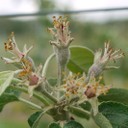 |
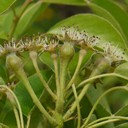 |
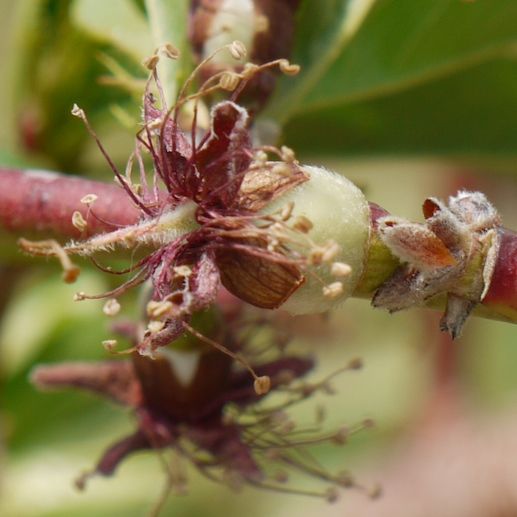 |
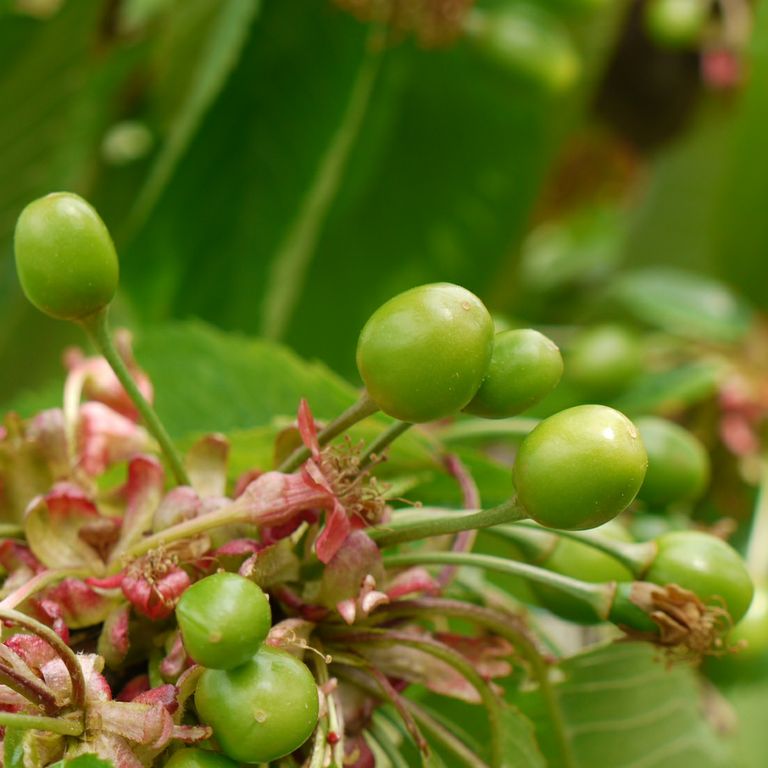 |
Orchard Radar insect synopsis
- Codling moth 1st generation, first sustained trap catch biofix date: May 2, Sunday
- Codling moth development as of May 4: 1st generation adult emergence at 2% and 1st generation egg hatch at 0%
- 1st Lesser Apple Worm (LAW) flight begins around: April 25. Peak trap catch: May 5, Wednesday.
- 1st generation Oriental Fruit Moth (OFM) flight starts: April 15, Thursday. 1st generation - 55% egg hatch and first treatment date, if needed: May 20, Thursday
- Increased risk of Plum Curculio (PC) damage as McIntosh and similar cultivars increase fruit size:
May 4, Tuesday. Earliest safe date for last PC insecticide spray: May 25, Tuesday - Spotted Tentiform Leafminer (STLM): 1st generation sapfeeding mines start showing: May 7, Friday. Optimum sample date is around Saturday, May 8, when a larger portion of the mines are visible.
- 1st generation White Apple Leafhopper (WAL) found on apple foliage: May 1, Saturday
- Sunday, May 1 McIntosh 95% petal fall; Wednesday, May 5 fruit set
The way I see it
A lot has happened in the last week including a rapid progression to fruit set in apples. Over the weekend conditions ramped up to a severe fire blight threat with rain which was realized yesterday (Monday). I suspect much streptomycin was applied to susceptible apple and pear orchards. There was also a minimal scab infection period. April was quite dry and scab should have been manageable. With wetting this week, that will likely be the end of primary scab season in the 'average' Massachusetts apple orchard. Most of this week looks good for applying petal fall thinners when the wind is calm. (i.e., warm temperatures mean thinners should work good.) I found some curculio damage on sweet cherry already, so they are out there and waiting for the next warm, humid evening to move into the orchard and cause damage. Don't forget you should also be getting fertilizer down, applying herbicides, etc. in addition to the regular crop protection activities. Are we having fun yet? JC
Massachusetts airports on NEWA
Through a cooperative effort with the New York State IPM Program, and the Northeast Regional Climate Center, Massachusetts airport locations have been added to the NEWA (Network for Environmental and Weather Applications) website (http://newa.cornell.edu). (Note that the map is draggable to the left wherein the Massachusetts airport locations are revealed on the map. You can also choose a location from the drop-down list.) Pests forecasts, typically based on temperature, precipitation, and relative humidity are available for various crops (fruit and vegetable). For apples, available forecasts include: codling moth, Oriental fruit moth, obliquebanded leafroller, plum curculio, spotted tentiform leafminer, apple maggot, apple scab, and fire blight. For example, here is the current (Tueasday, May 4) NEWA output for plum curculio (PC) for Chicopee Falls, MA:
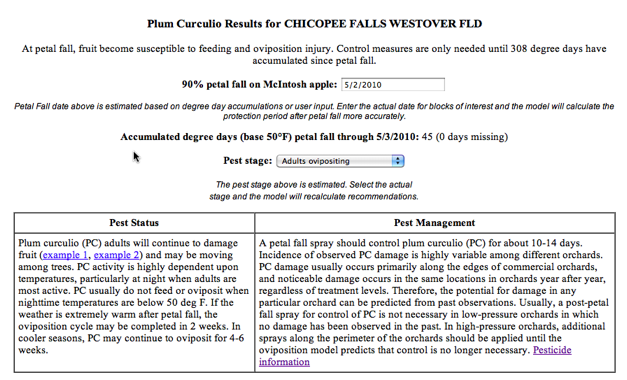
For more information on how to use NEWA, see Pest Forecasts in Real Time — NEWA in the April 19, 2010 issue of Scaffolds. I urge you to look at the NEWA website and give us your feedback. This is the future of IPM information delivery! JC
Petal fall thinning
This was sent out to the Healthy Fruit e-mail list late last week as some were going to be at petal fall over the weekend. The weather window for applying thinners and having them actually work looks pretty good for this week up until the weekend when a significant cool-down is expected. You are certainly encouraged to get some fruit thinning done this week!
Some of you may be at petal fall on McIntosh (and likely other varieties) by the end of the weekend or Monday. We are predicted to be at 95% petal fall for McIntosh at the UMass Orchard in Belchertown on Sunday. Depending on how you feel about pollination w injury(?), bee activity, and potential fruit set, here are 4 petal fall thinning options as presented by Duane Greene:
- Sevin XLR+ at 1 qt per 100 gallons dilute -- a safe and recommended option if you are on the fence about potential fruit set.
- NAA (Fruitone-N or -L) at 7.5 to 10 ppm (3 to 4 oz per 100 gallons dilute) -- an option if you prefer not to use Sevin. While these rates may seem high, NAA is not as potent a thiiner when applied at petal fall as it applears to be when applied at the 10 mm fruit size stage.
- Sevin XLR+ and NAA at the above rates -- the most aggressive petal fall thinning option if you are convinced you have good fruit set.
- NAD (Amid-Thin W) at 25-50 ppm (4 to 8 oz per 100 gallons dilute) -- good for early ripening varieties, Macoun, and more (see label).
Remember that your petal fall thinning spray starts the ball rolling, and fruit set will have to be evaluated at 5 to 10 mm fruit size (which may be sooner than later) for further action. Good luck.
Pest watch
- bacterial spot of peach and nectarine needs to be controlled now on susceptible varieties. Persistent sprays during wet weather of oxytetracycline (Mycoshield 17 WP or other) should begin at shuck split and continue for awhile; the best bet against bacterial spot is to avoid planting susceptible cultivars.
- cherry leaf spot sprays should begin now too; Bravo, Pristine, and Gem are rated excellent, however, several sterol-inhibitor fungicides (Indar, Rally, Orbit, Elite) can be used too. Most of these will control brown rot too.
- apple scab is still active at least for the rest of this week; your best defense is protectant sprays with Captan and/or EBDC fungicides; if you miss a protectant spray use something with kickback -- the Inspire Super MP is a good option right now for one of your last scab sprays (hopefully)
- fire blight could still be an issue through the end of the week if you have open bloom; be prepared to apply streptomycin if you get wetting and have open bloom in apples that are susceptible; Mycoshield is another option, however, it is not as good as streptomycin, but it might be wise to use if you have already applied strep.
- fabraea leaf spot in pears (Bosc very suscpetible) should have started by now but it has been dry; 1-2 cover sprays of EBDC fungicides or Ziram should continue or start if it is wet; Ziram can be continued throughout the summer, or Sovran, Flint, and Pristine can be used to control both fabraea and summer diseases (sooty blotch)
- peaches are going to get hit by tarnished plant bug (or stink bugs) at shuck split unless protected with an insecticide.
- petal fall is good timing to start worrying about various internal leps, aka 'worms,' including leafrollers, codling moth, and oriental fruit moth that are very well controlled by various new insecticides. Altacor or Delegate come to mind first, however, Intrepid, Voliam Flexi, Leverage, and Belt (among perhaps several others!) are all options too. Many of these control a wider range of pests too, including leafminer and plum curculio. Traditional petal fall and 1st cover sprays of Imidan also (hopefully) still work for internal leps, although we seem to be seeing more of them over time. (Resisitance? General range/host expansion? Who knows for sure.) Consider using one of these new insecticides if you seem to be having more of a problem with any of these internal leps. Good coverage with these insecticides is very important! And there is a good article by Larry Hull in the current edition of Scaffolds you should look at before using these products: